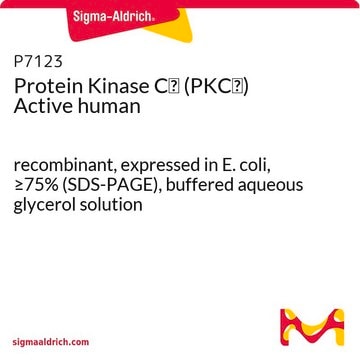05-850
Anti-p68 Antibody, clone204
clone 204, Upstate®, from mouse
Synonym(s):
Anti-G17P1, Anti-HUMP68, Anti-p68
Sign Into View Organizational & Contract Pricing
All Photos(1)
About This Item
UNSPSC Code:
12352203
eCl@ss:
32160702
NACRES:
NA.41
Recommended Products
biological source
mouse
Quality Level
antibody form
purified antibody
antibody product type
primary antibodies
clone
204, monoclonal
species reactivity
human, rat, mouse
manufacturer/tradename
Upstate®
technique(s)
western blot: suitable
isotype
IgG1
NCBI accession no.
UniProt accession no.
shipped in
wet ice
target post-translational modification
unmodified
Gene Information
human ... DDX5(1655)
General description
Also known as DDX5, p68 is a DEAD-box ATPase and RNA splicing factor.
Specificity
p68
Immunogen
Purified T antigen-related protein from Ad2+ ND2 virus-infected HeLa cells.
Application
Detect p68 with Anti-p68 Antibody, clone204 (Mouse Monoclonal Antibody), that has been shown to work in WB.
Research Category
Epigenetics & Nuclear Function
Epigenetics & Nuclear Function
Research Sub Category
Transcription Factors
RNA Binding Protein (RBP)
Transcription Factors
RNA Binding Protein (RBP)
Quality
Routinely evaluated by immunoblot of nuclear extracts from HeLa cells
Target description
68kDa
Physical form
Format: Purified
Protein G Purified
Storage and Stability
2 years at -20°C
Analysis Note
Control
Positive Antigen Control: Catalog #12-309, Hela cell nuclear extract. Add an equal volume of Laemmli reducing sample buffer to 10 μL of extract and boil for 5 minutes to reduce the preparation. Load 20 μg of reduced extract per lane for minigels.
Positive Antigen Control: Catalog #12-309, Hela cell nuclear extract. Add an equal volume of Laemmli reducing sample buffer to 10 μL of extract and boil for 5 minutes to reduce the preparation. Load 20 μg of reduced extract per lane for minigels.
Legal Information
UPSTATE is a registered trademark of Merck KGaA, Darmstadt, Germany
Disclaimer
Unless otherwise stated in our catalog or other company documentation accompanying the product(s), our products are intended for research use only and are not to be used for any other purpose, which includes but is not limited to, unauthorized commercial uses, in vitro diagnostic uses, ex vivo or in vivo therapeutic uses or any type of consumption or application to humans or animals.
Not finding the right product?
Try our Product Selector Tool.
recommended
Product No.
Description
Pricing
Storage Class Code
10 - Combustible liquids
WGK
WGK 1
Certificates of Analysis (COA)
Search for Certificates of Analysis (COA) by entering the products Lot/Batch Number. Lot and Batch Numbers can be found on a product’s label following the words ‘Lot’ or ‘Batch’.
Already Own This Product?
Find documentation for the products that you have recently purchased in the Document Library.
M J Ford et al.
Nature, 332(6166), 736-738 (1988-04-21)
The p68 protein is a highly conserved nuclear antigen that is thought to be important in the regulation of cell growth and division. It is found in dividing cells of all mammals and amphibians tested, but not in quiescent cells.
Kengo Takeda et al.
International journal of molecular sciences, 25(7) (2024-04-13)
Chronic myeloid leukemia (CML) is induced by the expression of the fused tyrosine kinase BCR-ABL, which is caused by a chromosomal translocation. BCR-ABL inhibitors have been used to treat CML; however, the acquisition of resistance by CML cells during treatment
Raphaël Métivier et al.
Cell, 115(6), 751-763 (2003-12-17)
Transcriptional activation of a gene involves an orchestrated recruitment of components of the basal transcription machinery and intermediate factors, concomitant with an alteration in local chromatin structure generated by posttranslational modifications of histone tails and nucleosome remodeling. We provide here
Zhi-Ren Liu
Molecular and cellular biology, 22(15), 5443-5450 (2002-07-09)
Modulation of the interaction between U1 snRNP and the 5' splice site (5'ss) is a key event that governs 5'ss recognition and spliceosome assembly. Using the methylene blue-mediated cross-linking method (Z. R. Liu, A. M. Wilkie, M. J. Clemens, and
Zheng Xing et al.
The Journal of biological chemistry, 295(27), 8988-8998 (2020-05-08)
DEAD-box helicase 5 (DDX5) is a founding member of the DEAD-box RNA helicase family, a group of enzymes that regulate ribonucleoprotein formation and function in every aspect of RNA metabolism, ranging from synthesis to decay. Our laboratory previously found that
Our team of scientists has experience in all areas of research including Life Science, Material Science, Chemical Synthesis, Chromatography, Analytical and many others.
Contact Technical Service








